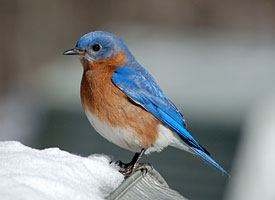We talk often about attracting birds to your yard. Hummingbirds and bluebirds, for example, are enjoyed by most bird watchers and are always a hot topic. What is less well known, is that the easiest way to begin a bird garden is simply to start with the birds already in your yard.
Why focus on existing bird populations
 When birds are finding their way into your yard with no existing bird feeders or purposeful landscaping, you already know you have plants they love and thus, the work to get started becomes much smaller. With a few small additions you can increase the population of some birds and encourage longer and more vibrant occupation by others.
When birds are finding their way into your yard with no existing bird feeders or purposeful landscaping, you already know you have plants they love and thus, the work to get started becomes much smaller. With a few small additions you can increase the population of some birds and encourage longer and more vibrant occupation by others.
Not to mention, it can be discouraging to spend money and time trying to attract an Oriole or Bluebird with little success. It can take as much as two seasons to attract these birds to your yard, why not enjoy the birds who already spend time there in the meantime?
3 Steps to identifying yard birds
Step One: Size and Shape
Birds can be broken into general categories by learning to recognize what general size and shape a species falls into. When first bird watching, it’s easy to become distracted by colors and feathers, but most bird species come in a variety of different colors–think finches in a rainbow of red, yellow, blue and more. Just remember that, no matter what the color, a finch is always almost the same size and shape. Once you learn to identify species by these factors, you’ll have an easier time narrowing down from there.
Step Two: Be aware of patterns
Cavity nesting birds, most likely to use a birdhouse, come in a variety of different sizes, shapes and colors. Although each is different, general color patterns are there if you pay attention. Birds fall into patterns based on:
- Light feathers and dark feathers: Be aware of the pattern between light and dark feathers. This is easier to identify quickly than the exact colors.
- Standing out or blending in: Whether or not the bird’s feathers are meant for gaining attention or blending in, can tell you a lot about what type of bird it is. For instance, House Finches usually stand out, with bold and aggressive color patterns. Whereas, Purple Finches have feathers designed for blending in and camouflage. Recognizing the subtle difference in coloring makes it easier to distinguish between two birds of a species.
- Show birds: Only a few species are so outrageously colored that they simply cannot be anything else. Learning to recognize male orioles and blood read cardinals is easy for even the most novice bird watcher. Start by learning the names of these gorgeous birds and work your way to the more subtle varieties from there.
Step Three: Behavior
Identifying the birds in your yard is about more than feathers. Believe it or not, if you spend much time watching birds, you’ll find that different species act different ways. Pay close attention to how the bird perches, eats or interacts with others and you’ll learn a lot about what type of bird it is, even if you can’t see the colors or patterns of the feathers.
Bird behavior falls into a few basic categories: posture, movement, flight pattern, feeding style and behavior around other birds. Learn to identify species by these different behaviors and you’ll have a much easier time knowing what birds are already sharing your space.
What type of birds started your bird watching adventures? We’d love to read your story in the comments!

